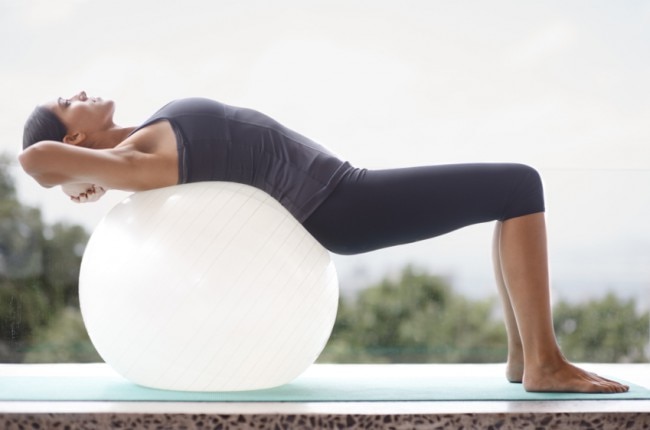Although most of us long for stability, sometimes a little shaking up has its place in the grand scheme of things. Incorporating a balance ball in your workout provides some much needed instability, forcing your body to strengthen its core to compensate for the chaos.
“Because it’s a moving surface, it requires you to engage your core to stabilize,” says Nan Fitzgerald, a master level personal trainer at Colorado’s Boulder Athletic Club. Core work—developing the muscles around the trunk and pelvis—has more to offer than merely defining abs. When you target the core, you include several other muscle groups along the back side of the body, such as the glutes. A study published in the May 2007 issue of the Journal of Strength and Conditioning Research found that crunches performed on a balance ball boosted abdominal activation by 24 to 38 percent over crunches done without a ball.
“Everybody needs core work,” says Fitzgerald. “I put balance and core strength in the ‘use it or lose it’ category. As we get older it seems like we lose our balance, but in truth it’s more accurate to say we don’t practice our balance as much.” Practicing balance entails emphasizing your core and training the pelvis, lower back, hips and abdomen to work in harmony.
To get your balance back in the groove—and the most bang for your belly—try Fitzgerald’s Balance Ball Action Plan.
Ball wall squats
How to do it: Position a balance ball against a wall. Stand with your lower back pressed against the ball, making sure your back is contoured against the ball. Your feet should be angled out about a foot away from you and hip’s width apart. Squat down, making sure your knees are perpendicular to your ankles. Keep your back contoured against the wall as you lower and rise. Try doing two to three sets of 8 to 12 squats.
What it targets: Gluteus maximus (glutes), quadriceps (quads)
Common mistake: Losing contact with the ball by letting hips and knees move forward
Challenge factor: Add weights and do bicep curls.
Back extensions over the ball
How to do it: Lie face down over the ball, with the ball under hips and waist, and feet on the wall for bracing. Put your hands behind your head, roll down over ball, and then roll up to neutral, leading with your head in both directions. Be sure to round down and up through the motion. Try doing two to three sets of between 10 to 15 reps.
What it targets: Lower back muscles, trapezius
Common mistake: Hyperextending the back by overarching
Challenge: Add reverse flies with light weight.
Ball bridge
How to do it: Lie on your back on a mat. Place your calves and heels on the ball with your legs almost touching, feet a few inches apart. Lift your hips off the floor. Your arms are out to either side to help stabilize your body. With an exhale, press up until your torso and legs form a straight line with each other. Avoid pushing your hips so high that your lower back begins to arch. Inhale, and slowly lower back to the floor. Try for three sets of 20 reps.
What it targets: Glutes and hamstrings
Common mistake: Allowing the hips to sag
Challenge: Raise one leg up toward the ceiling, alternating reps.
Ball Transfer
How to do it: Lie on your back and put the ball between your lower calves. Extend your arms flat over your head so that they still touch the floor. Pull your navel in tight and press your back down to the floor—keep this positioning throughout the exercise. Raise your legs up so they are perpendicular to your hips, and simultaneously raise your arms until they meet the legs and can access the ball. Holding the ball, lower your arms and legs back to the floor. Then reverse the exercise, passing the ball back to the legs. Do 15 to 20 reps.
What it targets: Deep and superficial abdominal muscles (transverse- and rectus abdominis)
Common mistake: Rocking back and forth instead of using muscular control and strength
Challenge: Lift head and shoulders up (thereby doing a crunch) each time you exchange the ball.
Pushups
How to do it: With the ball against the wall, place your hands wide on the side of the ball directly under your shoulders. Your chest lies directly over the top of the ball. Extend your legs and place both feet firmly on the floor, hip-width apart. Keeping head, torso and legs in alignment, exhale and slowly lower your body down toward the ball, then push back up to starting position (focusing on chest and core). Try doing two sets of 8 to 10 reps.
What it targets: Pectorals and triceps and core muscles (for stabilizing)
Common mistake: Not having chest centered over your ball.
Challenge: Raise one foot off the floor.
Balance responsibly
To make sure ball is right size: When sitting with knees properly aligned over the ankles, look for a 90-degree angle at knee.

